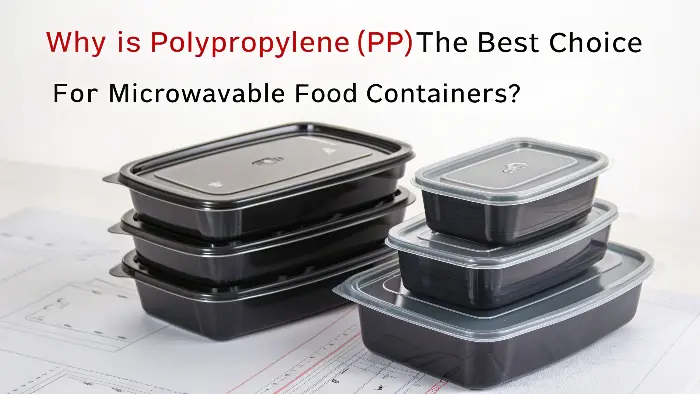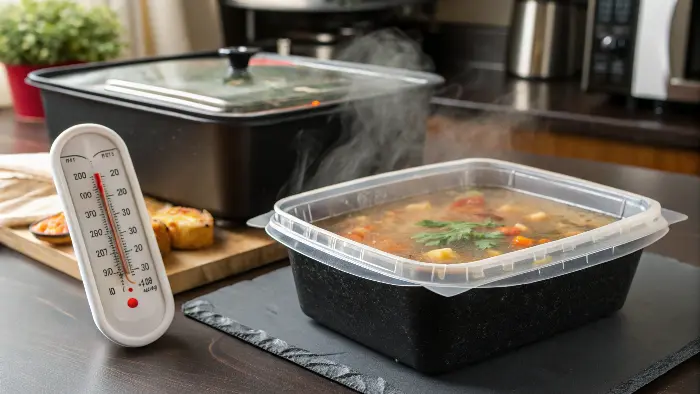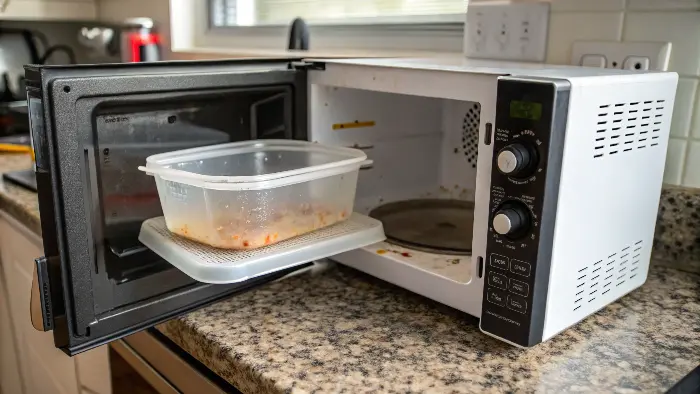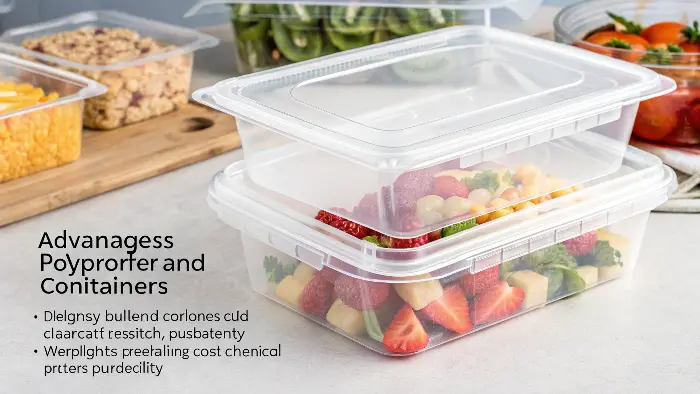Use of inappropriate material in your microwave may result in deformed containers, customer complaints, and even safety issues due to the leaching of chemicals. This may taint the image of your product. I am here to demonstrate a material that is reliable in addressing these issues and therefore makes your containers safe and long-lasting.
Polypropylene (PP) is most suitable due to its high temperature capacity and chemical inertness. It has a high melting point that can withstand the heating of microwaves without exploding or spilling poisonous elements. PP is also light in weight, resistant and a good shield against moisture and grease. Such a combination of safety, performance, and practicality makes it the best material to be used in reheating food hence both designers and consumers are at ease.

These are strengths in a very favorable position for PP, but where does it practically benefit a designer like you? In fully understanding why you consider PP your first-choice material, we need to understand in greater detail its specific attributes. Let’s investigate in detail how it holds up to heat, microwaving, and as a packaging material in general. It’s then your turn to make informed decisions for your forthcoming project.
Why is PP the best material for hot food packaging boxes?
Designing a hot food container is not a laughing matter. You use the wrong plastic, it can literally warp or even melt, destroying your food and your consumer’s confidence in you. Or worse, it might leach nasty chemicals into the food. But there exists a formulation of plastic specifically developed to meet the challenge of heat, both for the food’s safety and your own good name.
PP is perfect for hot food containers due to its extremely high melting point, in the region of 160-170°C (320-338°F). It, therefore, remains stable and solid well above the boiling point of water and does not warp or melt when hot soup is poured in or nuked in a microwave. Its very high heat deflection temperature guarantees the container retains its shape under load even when hot, and it is a safe and sure choice.

When we talk about a plastic’s ability to handle heat, we’re usually looking at two key numbers. It’s important to understand the difference.
Melting Point vs. Heat Deflection Temperature (HDT)
The melting point is the temperature that a material changes to liquid. For PP, this is quite high. The Heat Deflection Temperature (HDT) is of greater significance, however, to a container designer. HDT informs you of the temperature at which a material will begin to deform when the material is subjected to a certain load. A container must be able to maintain its shape particularly when it is being carried by a consumer full of hot food. PP is a material with a good HDT and hence it remains rigid and strong even in hot temperatures.
How PP Stacks Up Against Other Plastics
Let’s see how PP compares to other common packaging plastics. This can help you justify your material choice to your team or clients.
| Plastic | Typical Melting Point (°C) | Typical HDT (°C) at 0.45 MPa | Notes on Use with Heat |
|---|---|---|---|
| Polypropylene (PP) | 160 – 170 | 95 – 105 | Excellent for hot-fill and microwaving. |
| Polyethylene (HDPE) | 120 – 130 | 60 – 80 | Can handle warm-fill, but not ideal for microwaving. |
| Polystyrene (PS) | ~240 (amorphous) | 70 – 90 | Brittle. General-purpose PS is not for hot food. |
| PET (PETE) | ~255 | ~70 | Warps easily with heat. Not for microwaving (unless CPET). |
As you would notice, the combination of high melting point and a realistic HDT of PP makes it a decisive winner when it comes to heating related applications. I recall about a client using PS to package their takeaway containers. They were regularly receiving complaints concerning the containers to become soft and misshapen because of hot food. We assisted them in changing the mold and the material to PP and the issue vanished overnight. It is a mere change that can result in a big difference in the quality of products and customer satisfaction.
Polypropylene Applications in Food Packaging
Polypropylene is utilized in many forms in food packaging such as films, containers, and trays. Each use addresses a specific packaging need.
Flexible Packaging
Polypropylene’s most common usage is in flexible packaging. BOPP films, in particular, are very popular in packaging for lidding snack, baking, and confectionary food packaging. Such films are appreciated for their strength, clarity, and for their capability of offering a superior barrier against moisture.
Moisture and Gas Barrier
Polypropylene films also protect food products from the penetration of moisture and gases, whose entry can destroy food quality.
Cups and Bottles
Polypropylene is also used in the production of cups and bottles for beverages and condiments. Its lightweight and preservation of product freshness are among the factors why polypropylene is a popular packaging material for single-use and reusable drink packaging.
Upright Containers
Lightweight rigid polypropylene containers are popular for yogurt, milk products, and ready-to-eat food. As a product packaging material, they are tough, rigid, resistant to stress cracking, and impact resistant.
Microwaveable Containers
Since polypropylene possesses high heat resistance, polypropylene is a popular packaging material for microwave-safe containers such that food might be reheated in the packaging.
Food Trays and Clamshells
Polypropylene clamshells and trays are common packaging for baked products, meat, and vegetables. Its high impact strength and rigidity make it a perfect packaging for safeguarding food against abuses in transit and storage.
Modified Atmosphere Packaging (MAP)
It is compatible with MAP packaging, in which the packaging atmosphere is controlled in a way to enhance the shelf life of fresh produce.
Is polypropylene really safe for microwaves?
There is a lot of panic by many consumers with regards to microwaving plastic. Stories about how bad chemicals are in our food have circulated and it is a legitimate worry. This fear may cause individuals to be reluctant to purchase a product in the form of plastic. However I would like to assure you that at least in case of polypropylene, the science tells us that it is among the safest options you can make.
Yes, polypropylene is exceptionally safe for microwaves. Its molecular structure is non-polar, which means microwaves pass right through it without heating it up significantly. Instead, the energy directly heats the water molecules in the food. This prevents the container from melting and, more importantly, ensures that its stable polymer chains do not break down and leach harmful chemicals like BPA or phthalates into your meal.

To understand why PP is so safe, it helps to know a little about how a microwave oven actually works. It’s a fascinating piece of engineering.
How Microwaves Interact with Materials
A microwave oven produces, not surprisingly, microwaves. These are a form of electromagnetic wave. These waves make the polar molecules (such as the water in nearly all food) vibrate very fast. This vibration generates friction to create heat and cooks the food. Such materials as glass and some plastics, such as polypropylene, are non-polar. They lack the positive and negative ends which the microwaves can pick onto with their molecules. The microwaves therefore largely neglect the container and head directly to the food. That is why a PP container remains a lot colder than the food contained in it following the microwave.
The Importance of the "Microwave Safe" Label
When you come up with a container, it is important to mention that it is labeled as microwave safe. This tag displaying frequently with a symbol of wavy lines is not a mere marketing weapon. It is an indication to a consumer that the material has undergone testing and it is safe to be used in the microwave environment in accordance with the FDA guidelines. It will imply that the container will not leak chemicals in a harmful manner. Because PP works so well in this respect, you will discover that virtually every quality microwavable container is composed of it. It provides the consumers with confidence.
Chemical Stability is Key
The greatest concern is concerning chemicals. The positive thing is that PP is a highly stable polymer. It consists of long powerful chains of carbon and hydrogen. It does not have controversial chemicals such as Bisphenol A (BPA), which are at times, present in other plastics such as polycarbonate. These chains remain intact when it is subjected to microwave radiation. They do not disintegrate and emit toxic materials. This natural stability is the essence behind why PP is the material of choice when it comes to reheating food, not only in baby food boxes but in meal prep boxes as well.
What are the main advantages of polypropylene for food packaging?
A food container has to do more than just hold food. It needs to protect against moisture, be strong enough for transport, and be affordable to produce. If your material choice fails in any of these areas, it can lead to spoiled products and shrinking profit margins. Fortunately, one material offers a perfect balance of all these critical features.
The main advantage of polypropylene is its incredible versatility. It provides an excellent moisture barrier to keep food fresh and is highly resistant to chemicals, acids, and fats. It’s also very durable and has great fatigue resistance, perfect for containers with hinged lids. On top of that, it’s lightweight, which saves on shipping costs, and is one of the most cost-effective and easily recyclable plastics available today.

Beyond its heat resistance, PP has a whole suite of properties that make it a superstar in the packaging world. For a designer like Jacky, understanding these benefits is key to creating a successful product. Let’s break them down.
A Closer Look at PP’s Core Benefits
I’ve worked with many plastics over the years, and PP consistently stands out for its balanced performance. Here’s a table summarizing why it’s so popular:
| Property | Why It Matters for Food Packaging |
|---|---|
| Chemical Resistance | It doesn’t react with acidic foods (like tomato sauce) or fats and oils. The container won’t degrade, and the food’s taste remains pure. |
| Moisture Barrier | PP is excellent at keeping moisture out and locking freshness in. This extends the shelf life of products like soups and salads. |
| Durability & Fatigue Resistance | It’s tough and doesn’t break easily if dropped. Its unique fatigue resistance means you can design "living hinges"—the kind you see on a Tic Tac box—that can be opened and closed thousands of times without breaking. |
| Low Density | PP is one of the lightest major plastics. This translates directly into lower shipping weights and reduced transportation costs, which is a huge plus for any business. |
| Cost-Effectiveness | For the performance it delivers, PP is a very affordable raw material. This allows you to produce high-quality packaging without breaking the budget. |
| Recyclability | PP is widely recycled (it’s plastic #5). As sustainability becomes more important to consumers, choosing a recyclable material is a smart move for your brand. |
Design Freedom for Mold Makers
From my own standpoint as a mold maker, PP is a superb material to use. It possesses excellent flow characteristics in injection molding. That means it can very readily fill out difficult molds with deep details and slim walls, allowing designers more freedom in design. We can produce containers that are not only efficient but are attractive as well. Such processability, in addition to all the other advantages, is why I routinely suggest PP to my customers who are designing innovative food packaging. It meets all the criteria.
Challenges of Using PP for Microwavable Food Containers
Polypropylene (PP) is mostly utilized in making containers of microwavable foods due to its weight, cost, and relative melting point. Nevertheless, though it has gained popularity, there are various problems that come along with the use of PP in microwave devices.
Heat Limitations.
Though PP is compatible with moderate heating in microwaves, it can bend, deform or be deformed under high temperatures. This may either deform lids or containers, which may result in spills.
Uneven Heating and Hot Spots
Microwaves can heat food unevenly and PP containers can have problems in distributing heat evenly. This may cause some hot spots locally, rendering the container difficult to touch or weakening some places.
Potential for Leaching
Although food-grade PP is regarded as safe, low-quality or recycles PP materials can leak chemicals into the surroundings when subjected to high frequencies of microwave heat. This casts doubts on food safety, particularly in long-term use.
Limited Transparency
In contrast to glass or certain hi-tech plastics, PP tends to be opaque or semi-transparent. This complicates food monitoring during the heating process, which may cause over cooking or overheating.
Staining and Odor Absorption.
PP will stain when exposed to oily or tomato-based foods and can hold on to strong odors. This eventually causes the containers to look unappealing and thus not so nice to use again.
Reduced Life Expectancy in comparison to others.
Another drawback is that use of microwaves may prematurely degrade PP containers compared to glass or Tritan. After repetitive heating and washing they may crack, become opaque, or be brittle.
Although PP is affordable and microwave-safe to some degree, its heat resistance, life cycle, and food safety are limited, which is why it is less of a good alternative to more sophisticated materials such as Tritan or glass.
Conclusion
Polypropylene is literally the clear choice for microwavable food packaging. Its superior heat resistance, safety when microwaved, and chemical inertness bring a sense of security. Combine those benefits with polypropylene’s durability, lightweight nature, and price competitiveness, and you’ve got a material that satisfies designers, processors, and end-users alike. It’s a solution where you can literally own your molding and produce a superior product.
